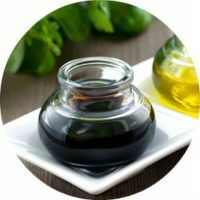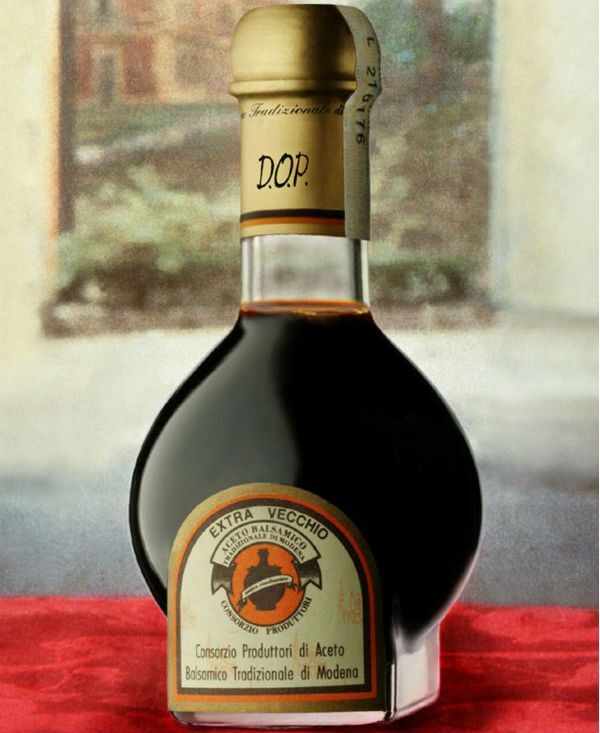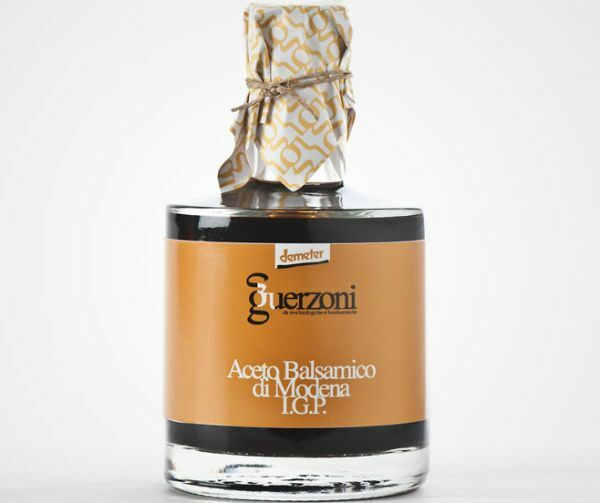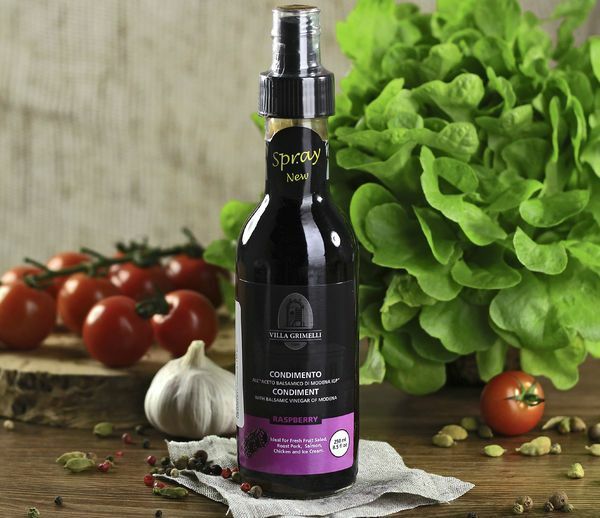
Balsamic vinegar or balsamic is an elite seasoning for vegetable, meat dishes and even desserts. This is quite an expensive treat among seasonings. Provided, of course, that the product is a real, not a cheap fake. The refinement of this seasoning can be inferred by the way it is prepared. After all, it, like elite alcohol, is aged for several years in oak barrels, and the longer, the better it turns out. The minimum period of exposure is 1-2 years, and the maximum can reach 12 to 100 years.
- chemical composition
- Recipe
- Types
- Tradizionale( DOP)
- Balsamic vinegar of Modena( IGP)
- Condimento
- Useful properties
- Methods of Use
- How to choose
- As store
- What can replace
- Harm and contraindications
chemical composition
In terms of its chemical composition, it is a product that is rather rich in useful components. It contains:
- organic acids - acetic and pyruvic;
- pectin;
- macro and trace elements - potassium, calcium, sodium, copper, manganese, phosphorus, magnesium, iron and zinc;
- vitamins - C, A, group B.
In terms of energy value, the refined product contains:
- carbohydrates - up to 17%;
- proteins - up to 0.5%;Ash
- - 0,37%;
- water - 70%;
- fats are completely absent.
Cooking recipe
The first mention of balsamic is dated to the middle of the 11th century. For the first time a barrel with an unusual product was presented to the future King Henry II from Count Boniface.
Balsamic vinegar is prepared only from the juice of white grape varieties. This juice boils and evaporates to a thick syrup, acquiring a dark brown color. When the syrup is ready, it is poured into barrels, in which it is kept until ready. For its aging and maturing, 3 types of barrels are used:
- small - from ash or oak;
- medium in size - from chestnut or cherry;
- large - made of mulberry.
At the same time, the ripe and ready product is produced in the smallest barrel. After a certain time, about 1/5 of it is cast, which can be sent for sale.
In this small barrel is added still unready syrup from the middle barrel, and in the middle - from the largest. And this way, in small portions, is the preparation of real balsamic vinegar. And for that period, while the syrup is in barrels, various spices are added to it, but these recipes are kept by the manufacturers and are not disclosed.
Given the fact that originally balsamic vinegar could only be made by representatives of noble families( this was considered a privilege!), The circle of producers was very limited. Initially, it was done in the Italian provinces of Modena and Reggio nel Emilia.
Recipes in different families were slightly different, but up to now, 3 main types of this seasoning have come down, which are considered real and are certified. In addition to differences in production technology, each species is different and at a cost. And for the differences and identification of the authenticity of the species at the international level, it was decided to label them with different labels.
Types of
There are 3 generally recognized categories of balsamic vinegar.
to the table of contents ^Tradizionale( DOP)

It is traditional because, as before, it is produced in the provinces of Modena and Reggio nel Emilia. This is considered the most real and the most "right" balsamic. To be certified as such, the composition should not contain anything other than grape must, and the exposure should be more than 12 years. For the production of mainly used 2 varieties of grapes - Lambrusco or Trebbiano.
Just for this category, a division is devised, which is marked by different labels. Red says that the product is aged not less than 12 years, silver - 18 years, gold - the prescription assumes not less than 25 years of aging.
to the table of contents ^Balsamic vinegar from Modena( IGP)

A fairly common variety that is easy to find on the shelves of grocery stores, and the product will be genuine. Of course, this is not so expensive product as the previous category. But this is also a good quality product, which is bottled exactly in Modena, as indicated by the IGP tag on the label.
Due to the fact that this sort of vinegar is made from different grapes, and even with the addition of wine vinegar( which accelerates the fermentation process and, accordingly, accelerates the production technology), it can have different flavor tints. This is another difference from a traditional variety, which always has the same taste.
to the table of contents ^Condimento

This is a "picky hodgepodge", since in this way all the varieties that do not fall under the 2 previous categories are designated. This does not mean that the grades of this category are of very low quality, just in this case the quality can be determined only by appearance and density, and then if through the glass of the bottle this is understandable.
This category is not regulated by any standards, so the quality is not controlled: you can buy a very good natural product for a little money, even without adding side-products like wine vinegar, and you can run into a blatant forgery.
to contents ^Useful properties
- This substance was named "balsamic" because it was first used to treat wounds.
- Balsamic vinegar is a strong antioxidant and has antibacterial and antiseptic properties. Polyphenols seasoning kill free radicals in the tissues and cells of the body, thereby protecting them from premature aging and cancer development.
- In combination with olive oil, balsamic vinegar improves the process of digesting heavy foods and lowers cholesterol.
- Normalizes the work of the heart, digestive system, vessels, brain, eyes, nervous system, metabolism.
- Strengthens the immune system, protecting the body from infectious ailments.
Ways of using
Concerning the taste characteristics of balsamic vinegar, this is definitely a seasoning for gourmets. Most often it is added as a dressing for vegetable salads and marinades to fish and meat. Balsamic vinegar creates an exquisite taste and unique flavor.
Its good to use for pickling any meat for cooking in a frying pan or in the oven. It goes well into hot vegetable snacks and fish dishes, giving them piquancy. In general, balsamic vinegar can be used everywhere, even in desserts. Its main highlight is sweet and sour taste, therefore it well emphasizes both salted and sweet dishes, which significantly expands its application area.
Although for the most part it is a question of balsamic vinegar and use in cooking, there are other options. Balsamic vinegar can also be used in cosmetology, for example, as a component of creams anti-aging series, anti-cellulite products and balms from hair loss.
to the table of contents ^How to choose
So as not to make a mistake in choosing a quality product, no matter what category it is, first of all you need to carefully study the label. You should pay attention to the identification marks, the country of origin and, of course, the composition.
If the composition includes only grape must, this is the first sign that such a product can be trusted. Also, depending on the aging period, the taste of balsamic vinegar also varies.
to contents ^How to store
With proper storage of balsamic vinegar from it, you can get a more refined seasoning. Of course, vinegar does not mature in the glass in the same way as in barrels, but this process continues. Therefore, you can buy a relatively inexpensive vinegar 1-2 years old and, without opening the bottle, leave in the pantry for a year or two. After that, the vinegar taste properties will improve. If possible, you can store a closed bottle and 12 years to get the most valuable product.
If the container with seasoning was opened, then there will be no ripening. Such vinegar should be stored in a shady place with a temperature of +6 to +20 degrees and use within a year. Do not overcool vinegar and expose to the sun.
Than to replace
Given that balsamic vinegar is a rather expensive ingredient, it is often replaced. Substitutes can be other types of vinegar - wine, apple, berry, table. In this case, you need to consider that the taste of the dish will not be the same as in the original.
Another point - if you decide to replace Italian balsamic, then do not use synthetic vinegar. After all, the damage to health is much more difficult to bear than the feeling that the dish turned out not so exquisite. But at least once in life it is worth buying a real balsamic to understand that this is really an extra-class product.
to contents ^Harm and contraindications
Balsamic vinegar is prohibited:
- for stomach and intestinal diseases;
- for individual intolerance.
If this product is not abused, then it will have an exceptionally positive effect on the body.
